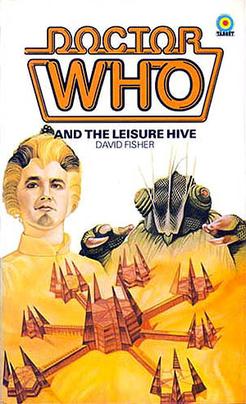Plot
This article's plot summary may be too long or excessively detailed.(October 2011) |
The Fourth Doctor and Romana's holiday in Brighton ends abruptly when K9 chases a ball, takes in seawater, and explodes. They instead venture to the Leisure Hive of Argolis, a holiday complex and message of peace built by surviving Argolins after their devastating 20-minute war with the Foamasi forty years earlier. They arrive at a point of crisis: the Leisure Hive is facing bankruptcy (because of falling tourist trade due to stiff competition from other leisure planets) and the Argolins' Earth agent, Brock, and his lawyer Klout have arrived bearing an offer to buy the planet outright. However, the offer is from the Foamasi, the only species that could live on the planet's radiation-infused surface, and the Argolin board will not consider it. The shock of events causes Board Chairman Morix's rapid death – from the Argolin war curse of advanced cellular degradation – and his consort Mena is declared the new Chairman. The Doctor is intrigued by the manipulation of tachyons in the Hive’s Tachyon Recreation Generator, which is the main tourist attraction and can duplicate and manipulate organic matter. He witnesses a human tourist being killed after it is sabotaged in the latest of a series of such acts.
When Mena returns to Argolis, her body clock begins to speed up, a side-effect of the radiation-heavy atmosphere. Earth scientist Hardin has been brought to Argolis to help her and her people by using time experiments to rejuvenate a people rendered sterile by the war. Recognising their value as scientists, Mena, instead of confining them, engages the Doctor and Romana to help Hardin with his work. The time travellers know Hardin has been faking his work, but Romana feels that the experiments should have worked.
After discovering a skin of Klout in a wardrobe, Stimson, Hardin's financier, who travelled with him and persuaded him to fake the demonstrations, is brutally murdered and the Doctor is blamed. He is put on trial while Romana and Hardin perfect the time experiments. Just in time, they succeed and are able to bargain for the Doctor's freedom. However, after they leave, the hourglass of their experiment shatters. Due to her worsening condition, Mena volunteers to be the first guinea pig to test the time experiment, but the Doctor is selected instead. The machine malfunctions while he is inside and he emerges – having aged 500 years – an old man with flowing white hair. Mena's son, Pangol, the most warlike and vindictive of the Argolins, orders that the Doctor and Romana be confined. Hardin later frees them, which is when the slower-witted Doctor notices something odd about the name Recreation Chamber. Romana sees it too, eventually: recreation is re-creation, the repeated creation of things or people.
Sneaking back to the Recreation Room, the trio discover a group of Argolins, led by Pangol, performing dangerous experiments in order to perfect a secret project, under the guise of entertainment. Meanwhile, Brock and Klout bring a new offer from a mysterious organisation called West Lodge. It is then, while tearing up the offer, that Pangol reveals the secret of his past and the reason he is the only young Argolin in the Hive. He was the only successful, undeformed child from a cloning experiment meant to save the Argolin using the Recreation Generator. But, driven insane by hatred of the Foamasi and a xenophobic fear of all aliens, he lusts for a war-forged empire like that of their ancestor Theron (who started the war and doomed the Argolins to extinction). He needs an alien witness to his taking Mena's place after her death, and to the beginning of "New Argolis".
The Doctor, Romana, and Hardin find Foamasi agents in the Hive and escort them to the council chamber, where the agents reveal Brock and Klout to be Foamasi impersonators. The lead agent reveals West Lodge to be a criminal group who need Argolis as a base of operations. With the leader, Brock, captured, the organisation is doomed to fold and the Foamasi prepare to take the rogues for trial. Pangol refuses to let them pass, and takes up the Helmet of Theron (a sacred symbol for Argolins and a reminder to espouse peace and understanding) and rallies the Argolins to his cause. The Doctor, seeing what he is up to, takes the Randomiser from the TARDIS and attaches it to the Recreation Chamber, hoping to destabilise the mechanism.
Romana tries to dissuade Pangol from using the Generator, but fails. The Foamasi shuttle tries to leave and is destroyed by Pangol, who dons the Helmet of Theron and uses the Generator to create an army of Tachyon replicas, in order to rebuild the Argolin race. He orders that Romana be put outside, while Hardin finds Mena dying and carries her to the Generator room. As Romana is taken, the clones are revealed to be merely tachyon images of a rejuvenated Doctor built up in a FIFO stack; first in, first out. She and the first Doctor to emerge (the real one) return to the Generator Room, where Hardin has put Mena into the Recreation Generator.
Pangol, enraged that the Doctor has foiled his attempt to create an army, reenters the Generator, which closes behind him. The Doctor reveals that he set the machine to "rejuvenate", and it cannot be stopped. Pangol and Mena seem to be merging, so the Doctor grabs the Helmet of Theron and throws it into the visualising crystal, stopping the mechanism. Mena exits rejuvenated, holding Pangol, who has regressed to a baby. The Foamasi agents reappear, revealing that the West Lodge criminals tried to escape in the shuttle (so, in the words of the Doctor "Brock and Klout are kaput"). Against Romana's advice, the Doctor leaves the Argolins and Foamasi to make up and the Randomiser attached to the Recreation Generator (thus leaving the TARDIS vulnerable to the Black Guardian).
